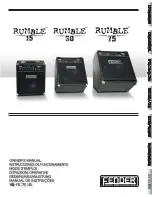
L-ACOUSTICS V-DOSC Manual Version 4
6/29/2005
Page 144 of 158
APPENDIX 2:
FURTHER EXPLANATIONS REGARDING WST CRITERIA
A detailed formulation of Wavefront Sculpture Technology Criteria was developed in “Sound
Fields Radiated by Multiple Sound Source Arrays”, AES preprint n°3269 (presented at the 92nd
AES convention in Vienna, March 1992). Further theoretical research was developed in
''Wavefront Sculpture Technology'', JAES Vol. 51, No. 10, October 2003. The following
explanation provides a more intuitive description of WST criteria with the intention of describing
where the ideas for the research that finally led to WST came from.
Returning to the interference problem introduced in Appendix 1, the time/frequency
relationship can be expressed in a different way, i.e., in the distance/wavelength domain.
Since
λ
= c / f (i.e., wavelength = speed of sound divided by the frequency) and
δ
d = c
δ
t (i.e.,
path length difference = speed of sound times the arrival time difference), pressure
cancellations occur when the path length difference between two wavefronts arriving at an
observation point M is:
δ
d = (2n + 1)
λ
/2
where n is an integer.
We can therefore conclude that discrete sound sources produce a totally incoherent wavefront
(due to comb filtering effects) as soon as the path length difference between the sources to a
given point M is greater than
λ
/2 (half a wavelength).
Let’s consider a line array or column of discrete sound sources providing almost equal pressure
levels at M. We want to find the conditions for constructive coupling of the sound sources for a
given frequency f = c /
λ
.
Assume that the time of the first arrival at M of this multiple source wavefront is t
i
= d
i
/ c
where it is seen in Figure 103 that the first arrival is due to source i (physically the closest source
to the listener position M).
Figure 103: Destructive interference ring for a line array at observation point M.
If a circle of radius d
i
is centered at M, it intersects source i. Recalling the condition that
δ
d = (2n + 1)
λ
/2, a second circle can be drawn with a radius of d
i
+
λ
/2, i.e., n = 0 in the
expression for the path length difference. If adjacent sources are inside the ring defined by
(d
i
, d
i
+
λ
/2) then they do not cause cancellation – they couple constructively. If sources are
outside the ring they may cause cancellation.
Содержание V-DOSC
Страница 1: ...Version 4 June 2005 V DOSC OPERATOR MANUAL ...
Страница 2: ...L ACOUSTICS V DOSC Manual Version 4 6 29 2005 Page 2 of 158 ...
Страница 20: ...L ACOUSTICS V DOSC Manual Version 4 6 29 2005 Page 20 of 158 Figure 6 V DOSC System Block Diagram ...
Страница 21: ...L ACOUSTICS V DOSC Manual Version 4 6 29 2005 Page 21 of 158 Figure 7 Example LR System Configuration ...
Страница 73: ...L ACOUSTICS V DOSC Manual Version 4 6 29 2005 Page 73 of 158 Figure 49 ARRAY 2004 Geometric Data for dV DOSC ...
Страница 116: ...L ACOUSTICS V DOSC Manual Version 4 6 29 2005 Page 116 of 158 a b c d e f g h ...
Страница 117: ...L ACOUSTICS V DOSC Manual Version 4 6 29 2005 Page 117 of 158 i j k l m n o p ...
Страница 118: ...L ACOUSTICS V DOSC Manual Version 4 6 29 2005 Page 118 of 158 q r s t u v w x ...
Страница 133: ...L ACOUSTICS V DOSC Manual Version 4 6 29 2005 Page 133 of 158 Figure 97 V DOSC Enclosure Line Drawing ...
Страница 156: ...L ACOUSTICS V DOSC Manual Version 4 6 29 2005 Page 156 of 158 ...
Страница 157: ...L ACOUSTICS V DOSC Manual Version 4 6 29 2005 Page 157 of 158 ...
Страница 158: ...L ACOUSTICS V DOSC Manual Version 4 6 29 2005 Page 158 of 158 ...















































